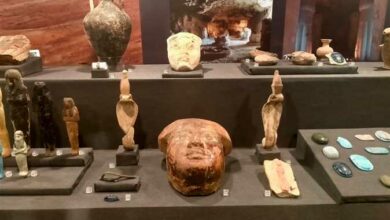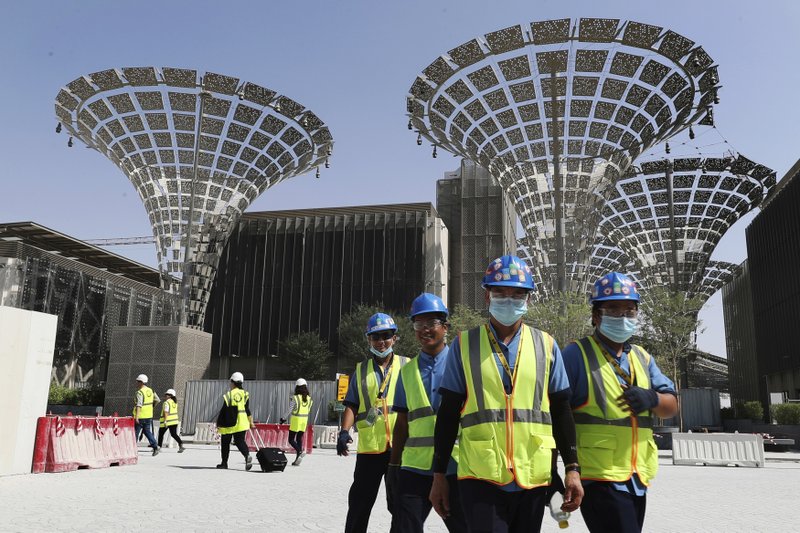Inside a Zamalek building overlooking the bustle of 26 July Street, the white walls of el-Masar Gallery play host to paintings, sculptures and photographs created by 31 contemporary talents.
While car horns honk among smoke-infused streets and the sun contemplates its slumber, a red carpet leads you into the opening night of Contemporary Views 3, an artsy, air-conditioned refuge containing enough works of art to gratify art enthusiasts left and right.
A quick glimpse at walls suffocated by color reveals the eminence of women as subjects in Contemporary Views 3. Two adjacent canvases, each several meters high, show full-length women dressed in galabiyas, painted in earthly tones. And female representations are featured heavily throughout the gallery’s maze.
Yellow paint highlights a girl’s head against a sea of blue. Women are shown on the covers of magazines, painted bluntly, surrounded by headlines.
More women are depicted in impressionistic style, with heads tilted downwards in sorrow. And from behind a lens, female bodies are captured and released onto the gallery’s walls.
However, it is through the eyes of male artists that we view these female forms. An overwhelming ratio of 29:2 evidences the dominance of men within Egypt’s contemporary art scene.
Spread out across a spacious wall are French magazine covers, painted to capture divas in their most glamorous moments. But surprisingly, alongside portraits of Mariah Carey and Celine Dion, we see–yes–US president and celebrity, Barack Obama.
Hany Rashed, the artist whose hands conspired to freeze these Western icons, explains his choice of subject: “I am an Eastern man, trying to illustrate the Western world.”
But while Rashed uses popular celebrities as his material, reflecting the Western everyman proved more challenging than he had anticipated. “I have traveled through Europe, and stumbled across men and women who live a totally different life. Instead of inspiring me, this confused me,” he says.
Rashed tried to paint the bodies of Western men and women, but was unable to craft their features. As an honest declaration of his confusion, Rashed painted their faces utterly white, a vacant visage for a façade yet to be deciphered by many Easterners.
Rashed’s most recent works have featured Western icons and celebrities. “I want to capture a single moment, an event that will forever leave its mark on history. The celebrities I paint will be remembered for the things they are saying and doing right now,” he says. “I am painting history as it unfolds.”
Influenced by prominent contemporary artist Mohammed Abla, Rashed seeks work outside the box at every opportunity. “I am constantly trying new styles of art, from abstract to impressionism, and I am not afraid of change.”
Storytelling is the business of Ayman Lotfy. Three women, shot in black and white, speak three thousand words. Lotfy, a fine art photographer, belongs to the school of thought that considers a picture to be a story loaded with messages, both explicit and veiled.
Lips, necks and shoulders take up most of the space on Lotfy’s canvases. Bare skin shines through in monochromatic tones, reflecting the artist’s passion for the human body. To avoid criticism of a society unwelcoming of nude photography, Lotfy chose a minimally invasive approach to conveying the energy lying within a woman’s body. “Waiting,” “Yours,” and “Pride” are the names of Lotfy’s pieces. His eyes tell stories he cannot speak; stories that hang on the walls behind him, sketched out in black and white.
“Black and white is the hardest type of photography,” says Lotfy. “You can only play around with two tones to reveal texture and dimension. It’s quite difficult, and that’s why we artists use black and white to show off our skills.”
Essam Darwish also explores the human body, or rather, sculpts the human body. A rectangle and a circle, dented strategically and apparently made of white-nickel plated bronze, rest atop a short white plinth. The sculptures demand respect, and lengthy deliberation–very likely, to no avail.
Darwish describes the life behind each sculpture with fervor. “This rectangle is actually the human torso, but I took its shape and essence, throwing away all the unnecessary organs inside.” A fleeting, unflattering image comes to mind, of gory hearts and–the flat-surfaced human body becomes suddenly very appealing.
“I play around with human beings, that’s what I do,” says Darwish.
The circle, in case you were wondering, was inspired by a man’s chest. And “the dents you see here represent every breath, every beat occurring within the human body,” says the artist.
A respite from the city’s hustle and bustle and a treasure-trove of modern Egyptian artwork, Contemporary Views 3 provides plenty to satisfy both the eye and the mind.
The exhibition runs until 9 August, at el-Masar Gallery in Zamalek.




